1997 CHEVROLET EXPRESS weight
[x] Cancel search: weightPage 184 of 386
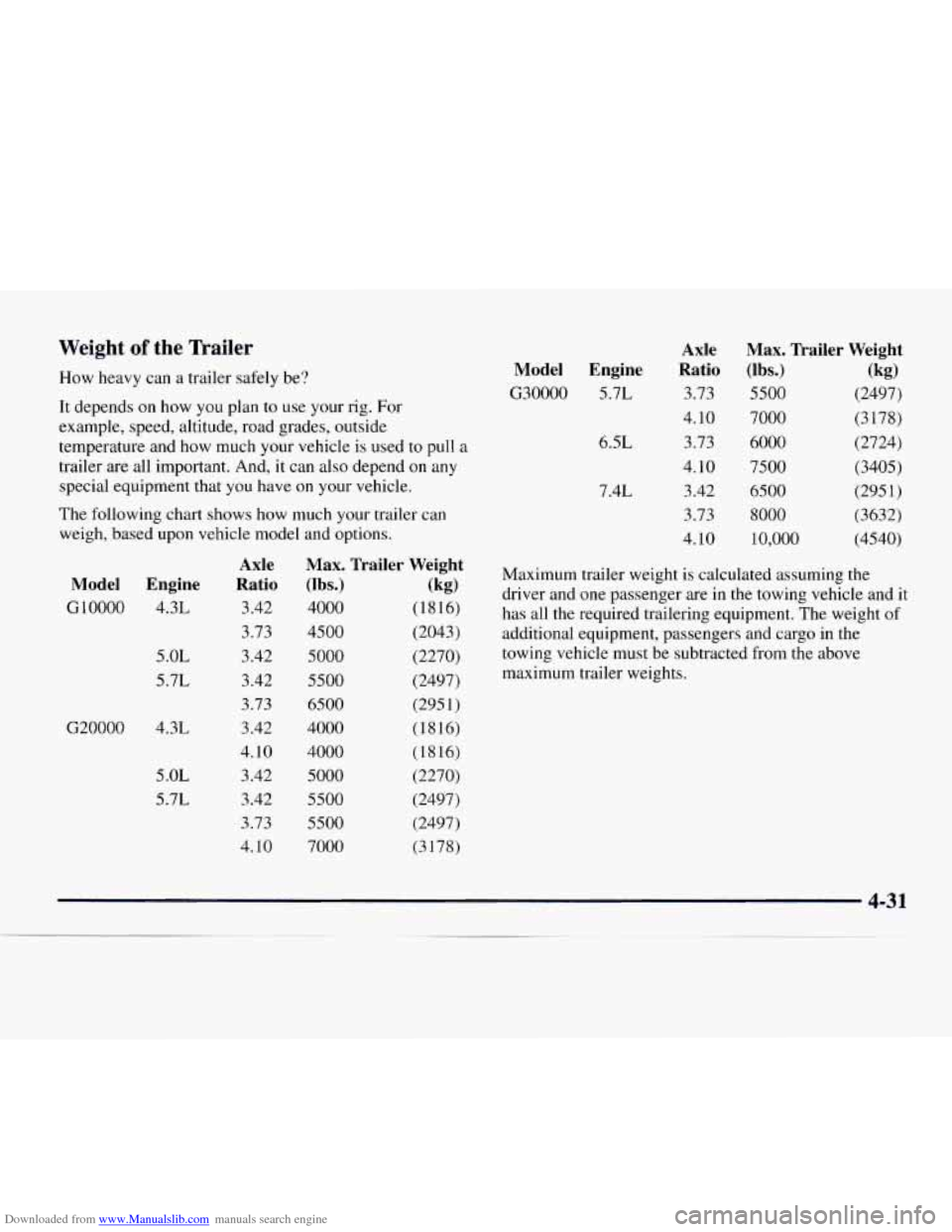
Downloaded from www.Manualslib.com manuals search engine Weight of the Trailer
How heavy can a trailer safely be?
It depends on how you plan to use your rig.
For
example, speed, altitude, road grades, outside
temperature and how much your vehicle
is used to pull a
trailer are all important. And,
it can also depend on any
special equipment that you have on your vehicle.
The following chart shows how much your trailer can
weigh, based upon vehicle model and options.
Model
Engine
GlOOOO 4.3L
5 .OL
5.7L
G20000 4.3L
5 .OL
5.7L
Axle
Ratio
3.42
3.73
3.42
3.42
3.73
3.42
4.10 3.42
3.42 3.73
4.10
Max. Trailer Weight
(Ibs.) (kg)
4000 (1816)
4500 (2043)
5000 (2270)
5500 (2497)
6500 (295 1)
4000 (1816)
4000 (1816) 5000 (2270)
5500 (2497)
5500 (2497)
7000 (3 178)
Model
Engine
G30000 5.7L
6.5L
7.4L
Axle
Ratio
3.73
4.10
3.73
4.10 3.42
3.73
4.10
Max. Trailer Weight
(lbs.) (kg)
5500 (2497)
7000 (3 178)
6000 (2724)
7500 (3405)
6500 (295 1)
8000 (3632)
10,000 (4540)
Maximum trailer weight is calculated assuming the
driver and one passenger are
in the towing vehicle and it
has all the required trailering equipment. The weight
of
additional equipment, passengers and cargo in the
towing vehicle must be subtracted from the above
maximum trailer weights.
Page 185 of 386

Downloaded from www.Manualslib.com manuals search engine You can ask your dealer for our trailering information or
advice, or you can write us at the address listed in your
Warranty and Owner Assistance Information Booklet.
In Canada, write
to:
General Motors of Canada Limited
Customer Communication Centre
1908 Colonel Sam Drive
Oshawa, Ontario
LlH 8P7
Weight of the Trailer Tongue
The tongue load (A) of any trailer is an important
weight to measure because it affects the total or gross
weight of your vehicle. The
Gross Vehicle Weight
(GVW) includes
the curb weight of the vehicle, any
cargo
you may carry in it, and the people who will be
riding in the vehicle. And
if you will tow a trailer, you
must add the tongue load
to the GVW because your
vehicle will be carrying that weight, too. See “Loading
Your Vehicle” in the Index for more information about
your vehicle’s maximum load capacity.
A B
If you’re using your platform hitch as a weight-carrying
hitch,
the trailer tongue (A) should weigh 10 percent of
the total loaded trailer weight
(B). If you’re using your
platform hitch as a weight-distributing hitch,
the trailer
tongue (A) should weigh
12 percent of the total loaded
trailer weight
(B).
After you’ve loaded your trailer, weigh the trailer and
then
the tongue, separately, to see if the weights are
proper. If they aren’t, you may
be able to get them right
simply by moving some items around in the trailer.
Page 186 of 386

Downloaded from www.Manualslib.com manuals search engine Total Weight on Your Vehicle’s Tires
Be sure your vehicle’s tires are inflated to the upper
limit for cold tires. You’ll find these numbers
on the
Certification label at
the rear edge of the driver’s door or
see “Tire Loading” in the Index. Then be sure
you don’t
go over the
GVW limit for your vehicle, including the
weight
of the trailer tongue.
Hitches
It’s important to have the correct hitch equipment.
Crosswinds, large trucks going by and rough roads are a
few reasons why you’ll need the right hitch. Here are
some rules to follow:
0 The bumpers on your vehicle are not intended for
hitches.
Do not attach rental hitches or other
bumper-type hitches
to them. Use only a
frame-mounted hitch that does not attach
to the
bumper. Do not use a ball hitch, because it could pull
the bumper
loose.
If you’ll be pulling a trailer that, when loaded, will
weigh more than
4,000 lbs. (1 800 kg), be sure to use
a properly mounted, weight-distributing hitch and
sway control
of the proper size. This equipment is
very important for proper vehicle loading and good
handling when you’re driving.
0 Will you have to make any holes in the body of your
vehicle when you install a trailer hitch?
If you’re using the wiring provided by the
factory-installed hitch,
you should not need to make
any holes in the body
of your vehicle. However, if
you have an aftermarket hitch installed, you may
need
to make holes in the body.
If you do, then be sure to seal the holes later when
you remove the hitch. If you don’t seal them, deadly
carbon monoxide (CO) from your exhaust can get
into your vehicle (see “Carbon Monoxide” in the
Index). Dirt and water can,
too.
Page 188 of 386
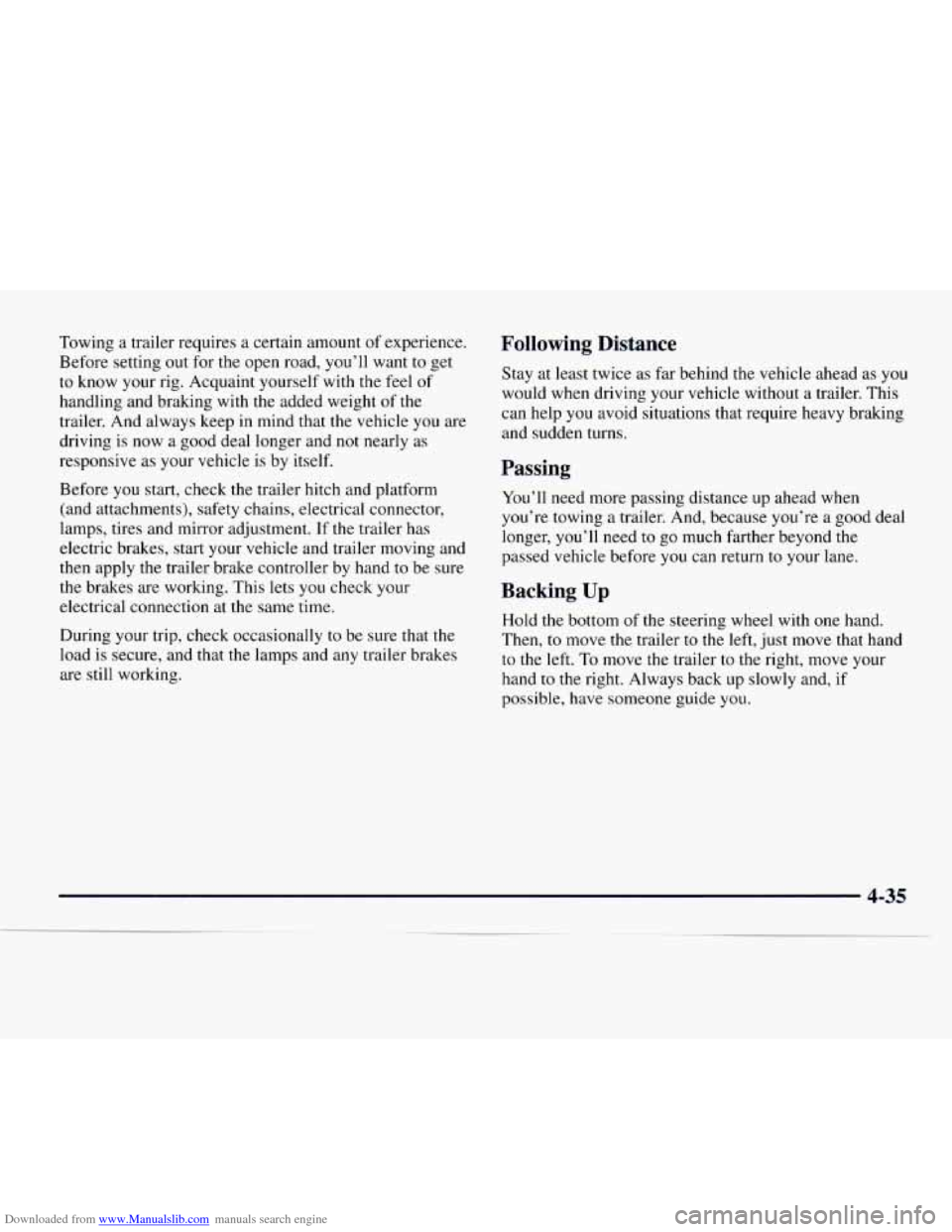
Downloaded from www.Manualslib.com manuals search engine Towing a trailer requires a certain amount of experience.
Before setting out for the open road, you’ll want
to get
to know your rig. Acquaint yourself with the feel of
handling and braking with
the added weight of the
trailer. And always keep in mind that the vehicle
you are
driving is now a good deal longer and not nearly as
responsive as your vehicle is by itself.
Before
you start, check the trailer hitch and platform
(and attachments), safety chains, electrical connector,
lamps, tires and mirror adjustment. If
the trailer has
electric brakes, start your vehicle and trailer moving and
then apply the trailer brake controller by hand to be sure
the brakes are working. This lets you check your
electrical connection at the same time.
During your trip, check occasionally
to be sure that the
load is secure, and that the lamps and any trailer brakes
are still working.
Following Distance
Stay at least twice as far behind the vehicle ahead as you
would when driving your vehicle without a trailer. This
can help you avoid situations
that require heavy braking
and sudden turns.
Passing
You’ll need more passing distance up ahead when
you’re towing a trailer. And, because you’re a good deal
longer, you’ll need
to go much farther beyond the
passed vehicle before you can return to your lane.
Backing Up
Hold the bottom of the steering wheel with one hand.
Then,
to move the trailer to the left, just move that hand
to the left.
To move the trailer to the right, move your
hand to the right. Always back up slowly and, if
possible, have someone guide you.
4-35
Page 204 of 386
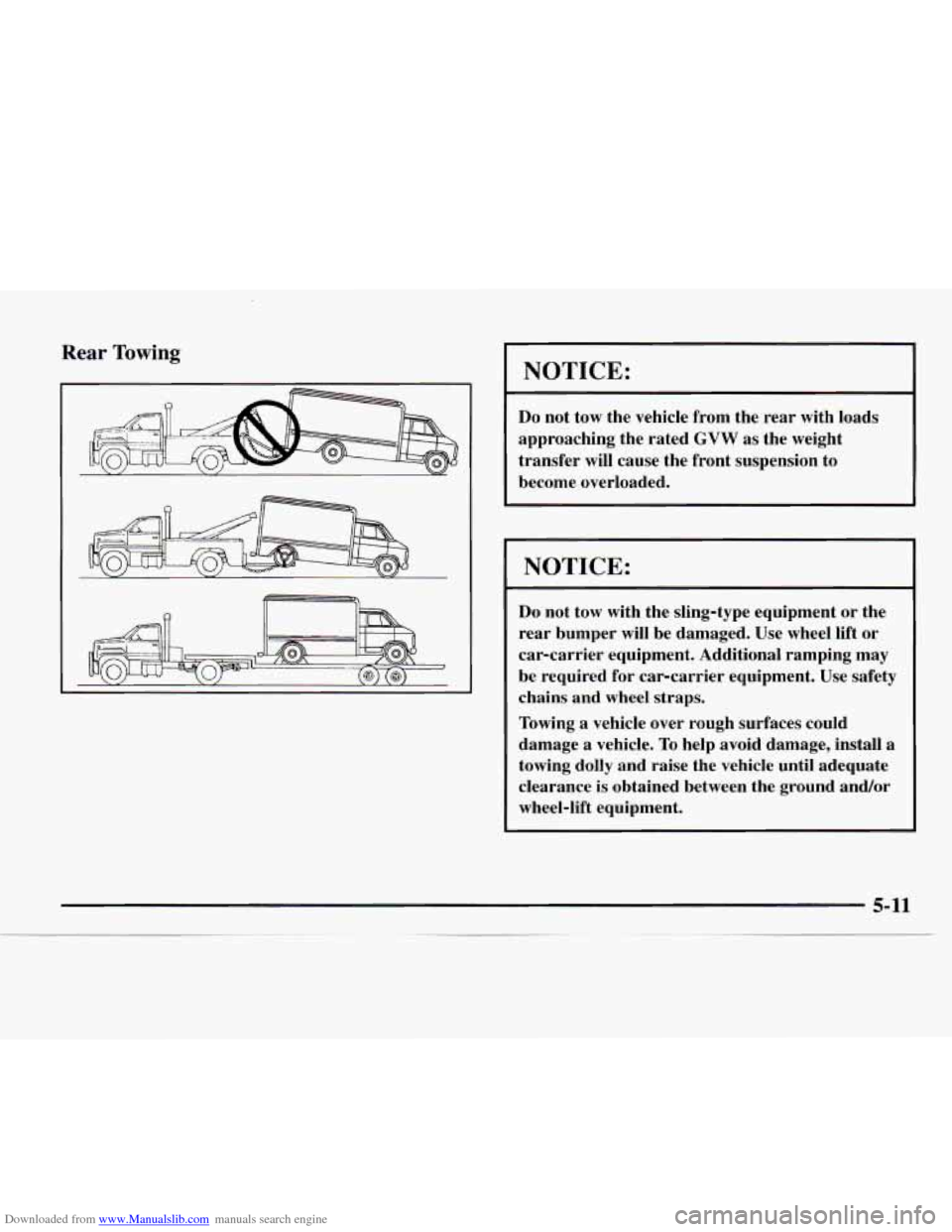
Downloaded from www.Manualslib.com manuals search engine Rear Towing
a
NOTICE:
Do not tow the vehicle from the rear with loads
approaching the rated
GVW as the weight
transfer will cause the front suspension
to
become overloaded.
NOTICE:
Do not tow with the sling-type equipment or the
rear bumper will be damaged. Use wheel lift or
car-carrier equipment. Additional ramping may
be required for car-carrier equipment. Use safety
chains and wheel straps.
Towing
a vehicle over rough surfaces could
damage a vehicle.
To help avoid damage, install a
towing dolly and raise the vehicle until adequate
clearance is obtained between the ground and/or
wheel-lift equipment.
Page 244 of 386
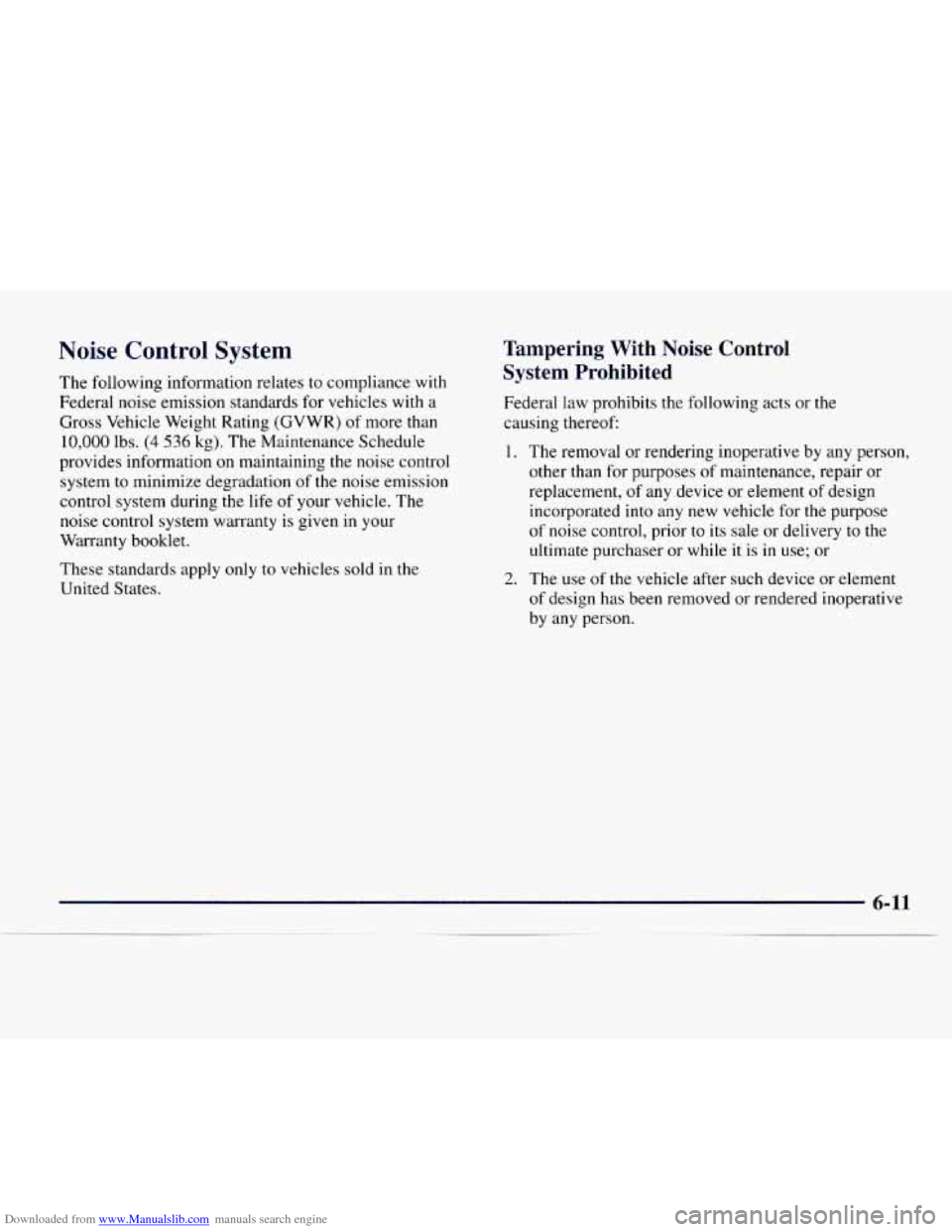
Downloaded from www.Manualslib.com manuals search engine Noise Control System
The following information relates to compliance with
Federal noise emission standards for vehicles with
a
Gross Vehicle Weight Rating (GVWR) of more than
10,000 lbs.
(4 536 kg). The Maintenance Schedule
provides information on maintaining the noise control
system to minimize degradation
of the noise emission
control system during the life
of your vehicle. The
noise control system warranty is given in
your
Warranty booklet.
These standards apply only
to vehicles sold in the
United States.
Tampering With Noise Control
System Prohibited
Federal law prohibits the following acts or the
causing thereof
1. The removal or rendering inoperative by any person,
other than for purposes
of maintenance, repair or
replacement,
of any device or element of design
incorporated into any new vehicle
for the purpose
of noise control, prior to its sale or delivery to the
ultimate purchaser or while it is in use; or
2. The use of the vehicle after such device or element
of design has been removed or rendered inoperative
by any person.
Page 377 of 386
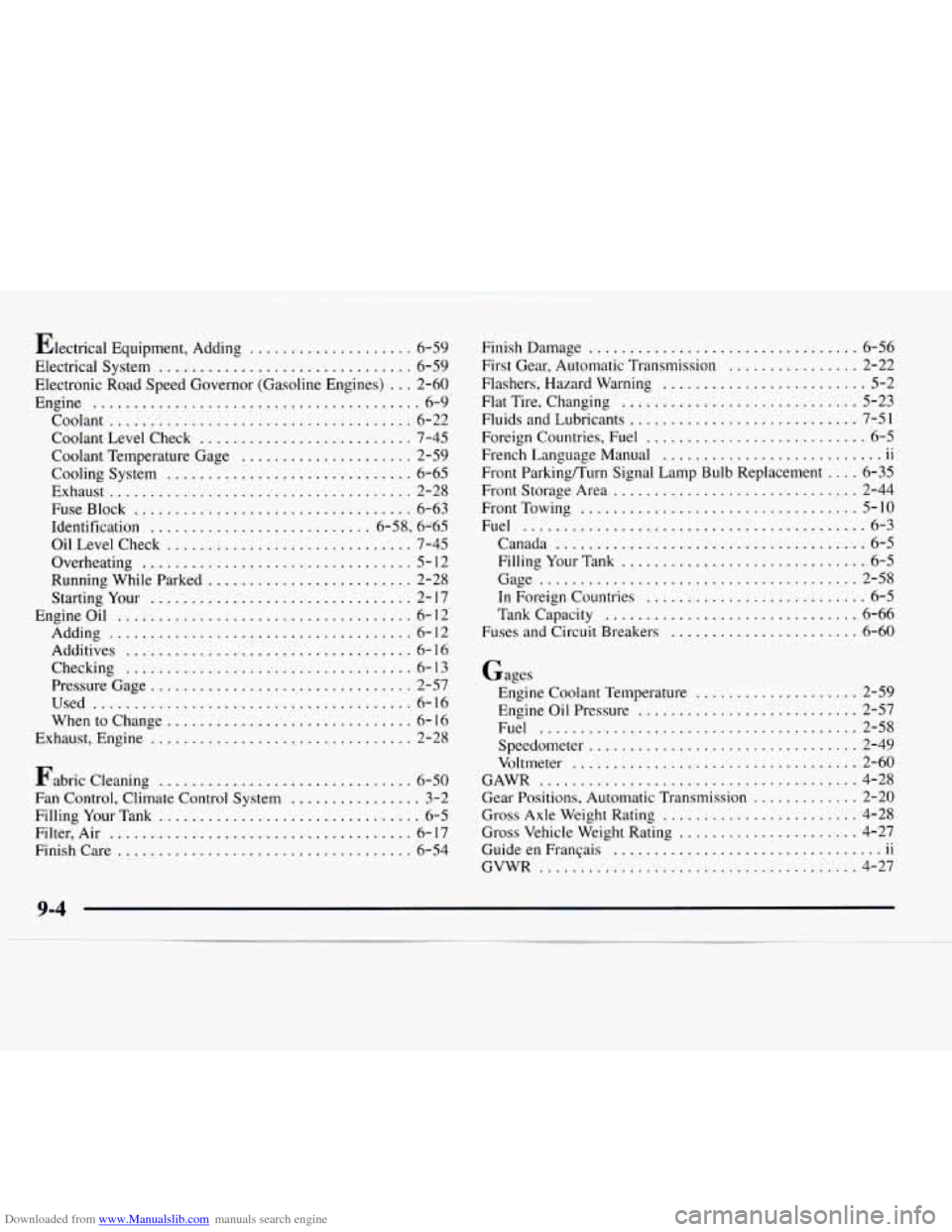
Downloaded from www.Manualslib.com manuals search engine Electrical Equipment. Adding
Electrical System
............
Electronic Road Speed Governor
Engine
....................
Coolant ..................
Coolant Level Check .......
Coolant Temperature Gage . .
Exhaust ..................
Fuse Block ...............
Identification .............
Oil Level Check ...........
Overheating ..............
Running While Parked ......
Starting Your .............
Engine Oil .................
Adding ..................
Additives ................
Checking ................
Pressure Gage .............
Used ....................
Cooling System ...........
................... 6-59
................... 6-59
(Gasoline Engines)
... 2-60
.................... 6-9
................... 6-22
................... 7-45
................... 2-59
................... 6-65
................... 2-28
................... 6-63
.............. 6.58. 6..65
................... 7-45
................... 5-12
................... 2-28
................... 2-17
................... 6-12
................... 6-12
................... 6-16
................... 6-13
................... 2-57
................... 6-16
Whentochange
.............................. 6-16
Exhaust. Engine
................................ 2-28
Fabric Cleaning
............................... 6-50
Fan Control. Climate Control System
................ 3-2
Filling Your Tank
................................ 6-5
Filter. Air
..................................... 6-17
Finish Care
.................................... 6-54 Finish Damage
................................. 6-56
First Gear. Automatic Transmission
................ 2-22
Flashers. Hazard Warning
......................... 5-2
Flat Tire. Changing
............................. 5-23
Fluids and Lubricants
............................ 7-51
Foreign Countries. Fuel
........................... 6-5
French Language Manual
11
Front ParkingKurn Signal Lamp Bulb Replacement .... 6-35
Front Storage Area .............................. 2-44
FrontTowing
.................................. 5-10
Fuel .......................................... 6-3
Canada
...................................... 6-5
FillingYourTank
.............................. 6-5
Gage
....................................... 2-58
In Foreign Countries
........................... 6-5
Tankcapacity
............................... 6-66
Fuses
and Circuit Breakers ....................... 6-60
.. ...........................
Gages
Engine Coolant Temperature
.................... 2-59
Engine Oil Pressure
........................... 2-57
Fuel
....................................... 2-58
Speedometer
................................. 2-49
Voltmeter
................................... 2-60
Gear Positions. Automatic Transmission
............. 2-20
Gross Axle Weight Rating ........................ 4-28
Gross Vehicle Weight Rating
...................... 4-27
Guide en Frangais
11
GVWR ....................................... 4-27
GAWR
....................................... 4-28
.. .................................
9-4
.
Page 383 of 386
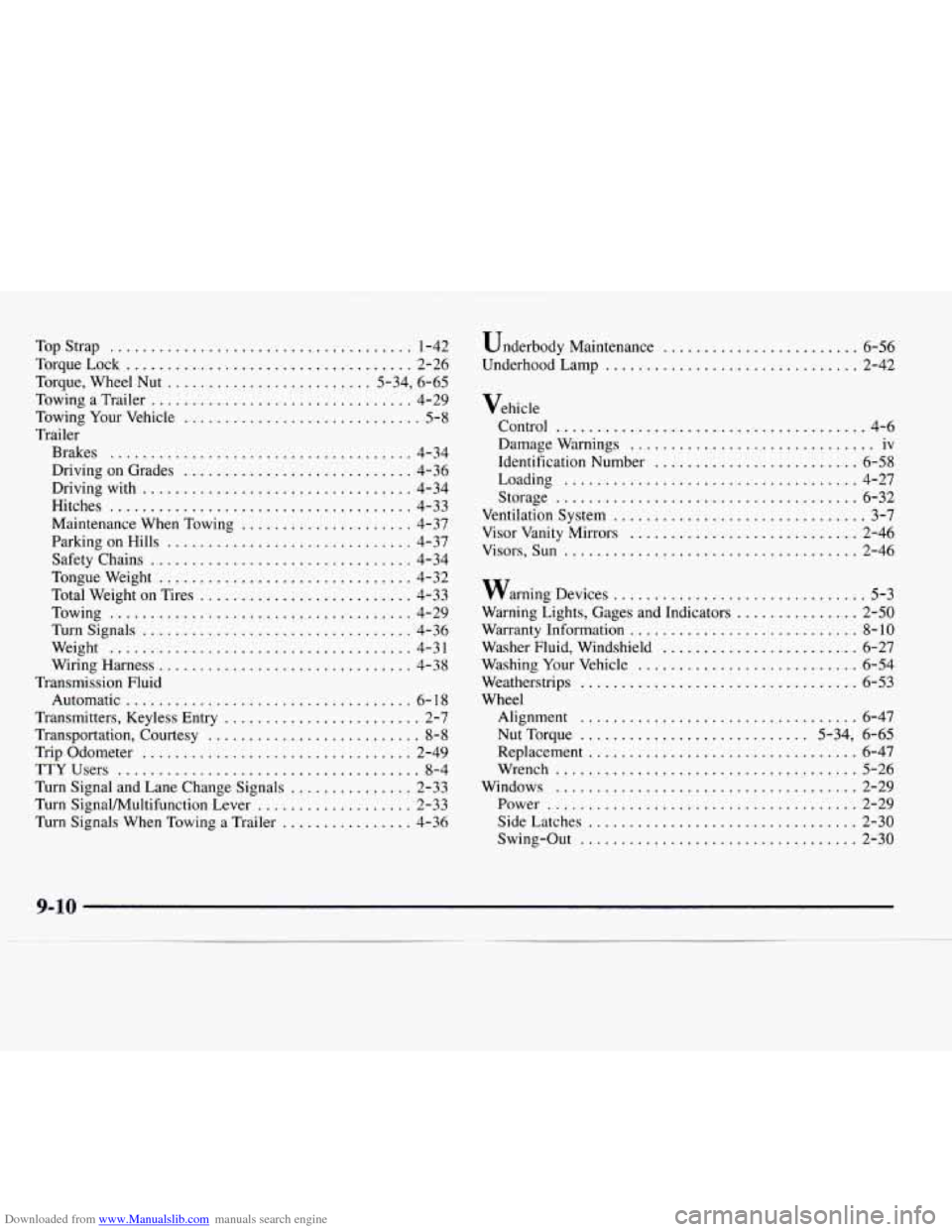
Downloaded from www.Manualslib.com manuals search engine TopStrap ..................................... 1-42
TorqueLock
................................... 2-26
Torque. Wheel Nut
......................... 5-34. 6-65
Towing a Trailer
................................ 4-29
Towing Your Vehicle
............................. 5-8
Trailer
Brakes
..................................... 4-34
Driving on Grades
............................ 4-36
Drivingwith
................................. 4-34
Hitches
..................................... 4-33
Maintenance When Towing
..................... 4-37
Parking on Hills
.............................. 4-37
Safety Chains
................................ 4-34
Tongueweight
............................... 4-32
Total Weight on Tires
.......................... 4-33
Towing
..................................... 4-29
Turnsignals
................................. 4-36
Wiring Harness
............................... 4-38
Transmission Fluid
Automatic
................................... 6- 1 8
Transmitters. Keyless Entry
........................ 2-7
Transportation. Courtesy .......................... 8-8
Trip Odometer
................................. 2-49
TTYUsers
..................................... 8-4
Turn Signal and Lane Change Signals
............... 2-33
Turn SignalMultifunction Lever
................... 2-33
Turn Signals When Towing a Trailer
................ 4-36
Weight
..................................... 4-31 Underbody
Maintenance
........................ 6-56
UnderhoodLamp
............................... 2-42
Vehicle Control
...................................... 4-6
Damage Warnings
.............................. iv
Identification Number
......................... 6-58
Loading
.................................... 4-27
Storage
..................................... 6-32
Ventilation System
............................... 3-7
Visor Vanity Mirrors
............................ 2-46
Visors. Sun .................................... 2-46
warning Devices
............................... 5-3
Warning Lights. Gages and Indicators
............... 2-50
Warranty Information ............................ 8-10
Washer Fluid. Windshield
........................ 6-27
Washing Your Vehicle
........................... 6-54
Weatherstrips
.................................. 6-53
Wheel
Alignment
.................................. 6-47
Nut Torque ............................ 5-34. 6-65
Replacement
................................. 6-47
Wrench
..................................... 5-26
Windows
..................................... 2-29
Power
...................................... 2-29
Side Latches
................................. 2-30
Swing-Out .................................. 2-30